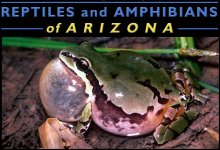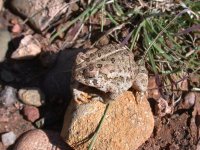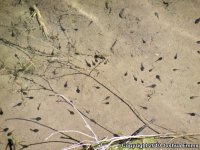| Range: |
 |
| Other Names: |
Woodhouse Toad |
| Subspecies: |
Rocky Mountain Toad Anaxyrus woodhousii woodhousii: Identified by light middorsal stripe, prominent cranial crests and elongated paratoid glands. Spots contain one to several warts. Belly usually white or yellowish with dark flecks between forelegs.
Southwestern Woodhouse's Toad Anaxyrus woodhousii australis: Light middorsal stripe usually does not extend onto snout; chest has extensive dark markings. |
| Description: |
Up to 5 inches in length, this toad has rough, warty skin, a whitish stripe down the middle of the back, and elongated parotoid glands on each side of the back of the head. This is usually a light brown or yellowish-brown toad with dark blotches and prominent cranial crests between and in front of the eyes. Males average a smaller size than females, have smoother skin, and possess a dark throat that is most noticeable during the breeding season. Tadpoles are dark brown, gray, or black, often with light mottling; the underside of the tail is lighter colored. Maximum tadpole length is about 1.2". |
| Similar Species: |
This toad can be distinguished from other frogs and toads by its rough, warty skin, a whitish stripe down the middle of the back, and elongated parotoid glands on each side of the back of the head. The Boreal Toad has small, oval paratoid glands and usually a gland of similar size on the shank. The cranial crests of Texas Toad and Arizona Toad are indistinct or absent. Great Plains Toads lack the white dorsal stripe. |
| Habitat: |
This species is found in a variety of wetland communities. It prefers areas in and near ponded permanent water, such as backwaters and slack water of big rivers, lakes, and irrigation ditches and canals; but can also be found at cattle tanks and other seasonal wetlands. They can be encountered in backyards or foraging under streetlights in rural or urban areas near such habitats. |
| Behavior: |
Mostly nocturnal, but juveniles are sometimes found active during the day. |
| Hibernation: |
|
| Reproduction: |
Along rivers, in agriculture, and at other permanent water in the deserts, breeding occurs as early as February and continues into June. Breeding occurs later at higher elevations, and at ephemeral ponds filled by the summer monsoons, the species breeds from June to September. The call is a nasal "waaah!" resembling the call of a sheep and is given by males in shallow water or on land near the water's edge. Calls are loud and audible over long distances. Up to 28,000 eggs are deposited in long stringers. Tadpoles metamorphose in 5-8 weeks. Hybridization with the Arizona Toad, Texas Toad, Sonoran Desert Toad and the Red-spotted Toad has been noted. |
| Diet: |
Woodhouse's toads eat a variety of arthropods, such as sowbugs, scorpions, bees, insect larvae, ants, and spiders. |
Adapted from species account at reptilesofaz.org
Sources:


|















